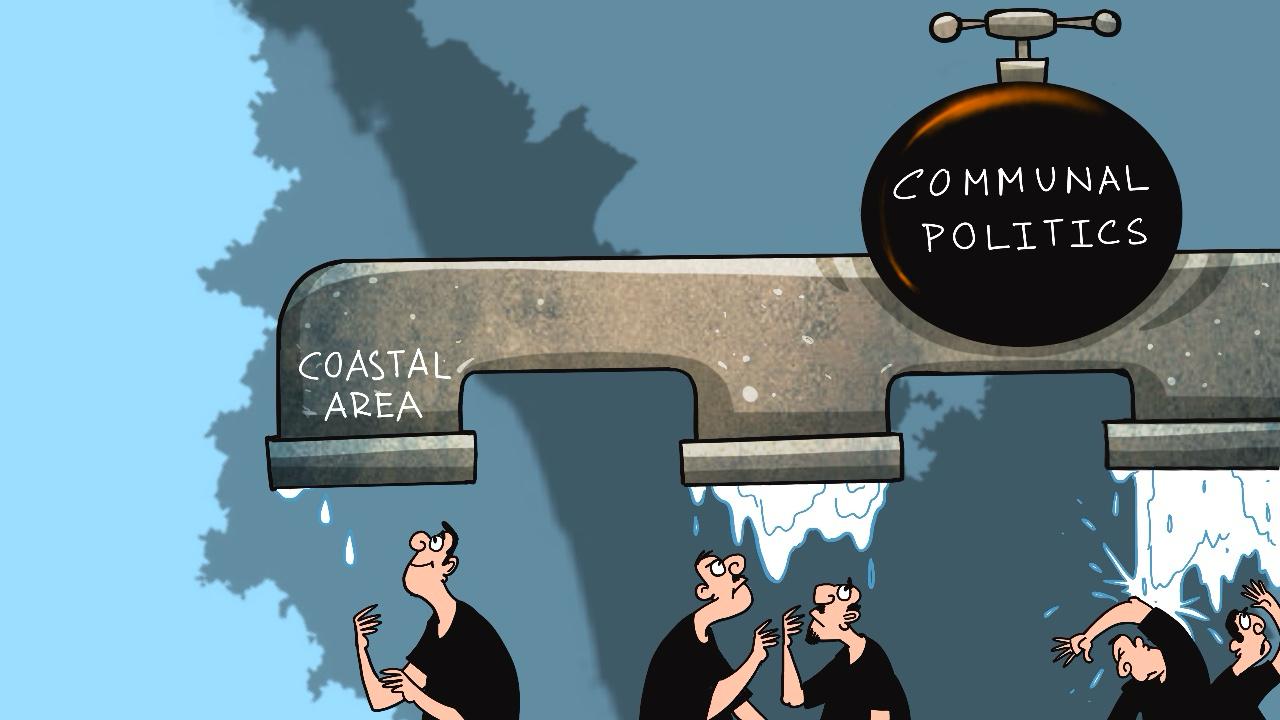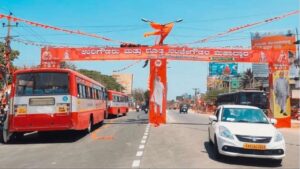While Coastal Karnataka has always been termed as southern India's 'Hindutva laboratory', the focus of these forces is now shifting to other parts of the state, including North and South Karnataka.
Published Nov 06, 2025 | 9:00 AM ⚊ Updated Dec 01, 2025 | 8:26 AM

Political observers and analysts also attributed the decline in Coastal Karnataka's communal incidents to an increased awareness about police action and a sense of fatigue or saturation among citizens after years of sustained tensions.
Synopsis: Karnataka is seeing a shift in communal politics. The south coastal region, once the hotbed of communal politics and the so-called moral policing, is reporting fewer incidents, even as interior regions, like Old Mysuru, are gradually emerging as the new fertile ground for the retrograde trend. Incidentally, it is the members of the Backward Classes who often end up in prisons for communal, violent acts.
February 2015, a classroom. Mohammed Riaz, a final-year computer science student of a Surathkal college in Mangaluru, was having a good time with friends. The group included five young women and a man, excluding Riyaz, all in college uniform.
Youthful exuberance was evident as the group chatted, laughed and clicked photographs on their mobile phones. They even shared the photographs with other friends, who further forwarded them over WhatsApp.
Little did Riyaz then know that one of the shared photographs would enrage a group belonging to a particular community. The photograph showed one of the young men sprawled across the laps of his female friends.
The painful reality — a reflection of growing intolerance and increasingly fragile religious sentiments — soon hit Riyaz hard. A group of self-appointed protectors of Hindutva kidnapped and thrashed Riyaz on 23 February 2015.
The student’s fault: His name, his faith. The assailants did not even check if it was really Riyaz who was lying on the women’s lap, an act that would not even qualify to be branded as a public display of affection.
Riyaz was in the group, and the communal intolerance that takes pride in compartmentalising and othering compatriots based on religion came into play. For the record, Riyaz did not lie on the women’s lap.
“After the photograph was circulated on social media, a vigilante group got other students from the college to identify the deviant youth and, on learning that he was probably a Muslim, decided to attack him,” The Indian Express reported, quoting Assistant Commissioner of Police Ravi Kumar.
The incident involving Riyaz was not an aberration. Society has been divided. Communalism has become real, fraying the secular fabric of Karnataka—and India.
Data compiled by Suresh Bhat Bakrabail, a member of the People’s Union of Civil Liberties (PUCL), Mangaluru, and Coastal Karnataka districts (Udupi, Dakshin Kannada and Uttara Kannada) revealed 35 cases of such moral policing by Hindu vigilantes and 11 by Muslim vigilantes in 2015.
It was the worst year in terms of communal incidents, with 228 such incidents being reported in the coastal region – the highest to date.
However, over the past few years, communal incidents have dipped in the coastal districts. They were at their lowest in 2024, with just 50 incidents being reported, including alleged instances of moral policing by Hindu, Muslim and unidentified vigilantes, hate speech, cattle vigilantism, and religious conversion.
This was the lowest number since Bakrabail started compiling the report in 2010.
The incidents are, however, shifting to the erstwhile state of Mysore — Old Mysuru as it is now known — an agrarian region that has rarely witnessed communal politics.
“This shifting is part of extension and deepening (of the Hindutva forces). The reduction in the number of communal incidents is incidental with the BJP attempting to make inroads into the Old Mysuru region with the help of JD(S),” said KP Suresh, a Mangalore-based analyst and political commentator.
Right-wing groups such as the Vishwa Hindu Parishad (VHP) and Bajrang Dal have a strong presence in coastal Karnataka. What makes these groups potent, according to analysts and political observers, is the participation of the youth, mainly from backward caste communities.
“These youngsters come from families traditionally lacking the social and economic capital to become upwardly mobile. Religious identity offers a refuge and a ticket to social mobility,” Professor Sanjal Shastri said.
Prof Shastri has extensively researched the region’s communal politics.
In one such research work titled ‘Identity, Politics and Competition: Localised Violence in Dakshina Kannada,’ Shastri noted how the majority of the entrants into these groups are from the Billava community (who are associated with toddy-tapping).
Over the past few years, there has been considerable anger among the Billavas over being sidelined by the Sangh Parivar.
The more overt form of this sidelining showed up when both the Congress and the BJP fielded members from the Billava community during the Assembly and general elections.
In 2018, one such long-time hardcore Hindutva activist and influential leader of the Billava community, Sathyajit Surathkal, issued an ultimatum to the BJP: give him a ticket to contest the Assembly elections by 10 am the next day or else he would announce his ‘further course of action’.
He was denied a ticket.
Since then, Surathkal, who has “built a significant support base amongst Billava youth,” according to Shastri, has openly criticised the BJP for sidelining the community in politics. In 2024, Surathkal urged his community members to vote only for Billava candidates, irrespective of their political affiliation.
Apart from electoral representation, Billavas have also been vocal about how their “community’s youngsters were ending up in jails.
Senior Kannada journalist, Naveen Soorinje, in his book ‘Netravathiyalli Nettaru: Karavaliya Komu Himseya Naija Prakaranagalu’ (Blood on the Netravathi: The Truth Behind Communal Incidents in Coastal Karnataka), explained that Billavas, the foot soldiers, were often made scapegoats in cases of communal incidents while the upper caste members of the Sangh went scot-free.
He cited an example. After a series of attacks on churches in coastal Karnataka in 2008, MB Puranik, a leader of the VHP, who is a Brahmin, and Mahendra Kumar, a leader of the Bajrang Dal, who is a member of a backward caste, jointly addressed a press conference where they accepted responsibility for the church attacks. While both of them gave similar statements, only the backward caste leader was arrested.
Tensions within the community came to a head in July 2022 after the murder of BJP worker and Billava youth Praveen Nettaru in the Dakshina Kannada district. Activists of Hindu organisations blocked the car of the BJP state president and DK MP Nalin Kumar Kateel, who were visiting the kin of the deceased youth.
Analysts said such developments fuelled a growing disillusionment in the community, discouraging many from joining the Sangh Parivar as foot soldiers.
Political observers and analysts also attributed the decline in Coastal Karnataka’s communal incidents to an increased awareness about police action and a sense of fatigue or saturation among citizens after years of sustained tensions.
“These groups are focused. While their leaders make statements at big rallies to influence the public, they also make sure to enter into neighbourhoods in the form of smaller meetings to ensure they seep into the very fabric of the society,” Mangalore-based activist Vidya Dinekar said.
KP Suresh explained that the caste dynamics of coastal Karnataka have little influence on the state’s broader political landscape.
“If a party wants to expand its reach, it must capture either the Lingayat or Vokkaliga strongholds. The Lingayats are already aligned with them (BJP), while the Vokkaligas have largely stayed away from the Hindutva bandwagon,” he told South First.
With the JD(S) now co-opted by the BJP, making inroads has become easier — so the decline in communal incidents (in coastal Karnataka) is more incidental than intentional,” he added.
While Coastal Karnataka has always been termed as southern India’s ‘Hindutva laboratory’, the focus of these forces is now shifting to other parts of the state, including North and South Karnataka.
According to the Home Department data presented in the Assembly in December 2024, 26 communal incidents were reported in Mandya, 13 in Belagavi, nine in Dharwad and six in Mangaluru.
One such communal incident reported recently was from Maddur in the Mandya district. Violence broke out during a Ganesh visarjan procession when a few ‘miscreants’ allegedly threw stones as it was passing by a local mosque in the Ram Rahim locality.
The youth in the procession retaliated, leading to a communal clash between the two communities. Thereafter, BJP leaders started making provocative statements: CT Ravi threatened to behead those who dared to challenge the Hindus. Others accused the Congress government of being anti-Hindu.
The next day, BJP district president Dr NS Indresh and leaders of other Hindu organisations took out a procession in a show of strength.
The Maddur clash was not a one-off incident. A similar incident occurred in September 2024 during a Ganesh Chaturthi procession in Nagamangala in the Mandya district.
The procession halted for a long time near a local mosque, prompting a heated argument between members of the two communities. Stones were pelted at the procession, which escalated into a clash between the two communities. Shops owned by both Hindus and Muslims in the area were set ablaze.
Ahead of the 2023 Assembly elections, the BJP had invoked two fictional Vokkaliga chieftains, Uri Gowda and Nanje Gowda, who apparently killed 18th-century Mysore ruler Tipu Sultan. BJP workers erected a huge arch hailing the two Gowdas before Prime Minister Narendra Modi’s visit to Mandya.

The arch named after ‘Uri Gowda’ and ‘Nanje Gowda’, purportedly two fictitious Vokkaliga chieftains and brothers, who the BJP claims “killed” Tipu Sultan, the ruler of the erstwhile kingdom of Mysuru.
The arch was later removed following public outcry over the distortion of historical facts.
Suresh pointed out that Mandya has been a Vokkaliga-dominated region, long a stronghold of the JD(S). Traditionally, the Congress and JD(S) have been locked in a fierce electoral contest, leaving the BJP struggling to gain a foothold.
However, with the JD(S) and BJP joining hands ahead of the 2024 elections, Bakrabail said the saffron party has gradually been making inroads into the Old Mysuru region, promoting its brand of saffronisation.
Despite this shift to other parts of the state, communal incidents did make a return to coastal Karnataka earlier this year, with three back-to-back murders.
In April 2025, 38-year-old Ashraf, a migrant worker from Kerala, was lynched in Mangaluru for allegedly raising pro-Pakistan slogans during a local cricket match. His brother, Abdul Jabbar, later said the deceased was mentally unsound.
Suhas Shetty, a former Bajrang Dal activist and history sheeter, was hacked to death on 1 May by seven armed men. On 27 May, Abdul Rahiman, a mosque secretary and driver, was murdered while unloading sand in Bantwal.
Political analysts are cautious. They are reluctant to declare the coastal regions free of communal politics. They feel it is hanging over the region like the proverbial Sword of Damocles.
(Edited by Majnu Babu).
